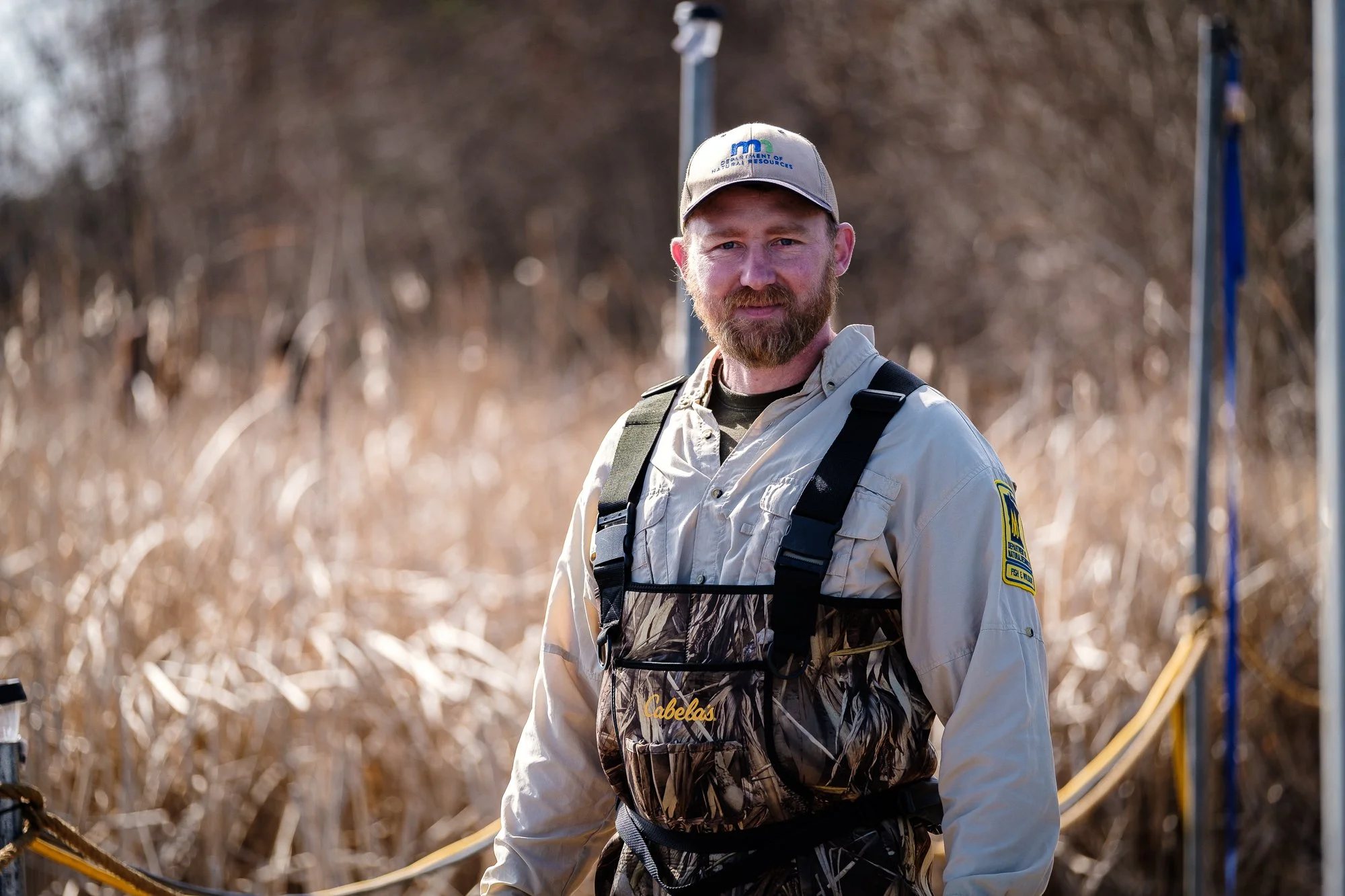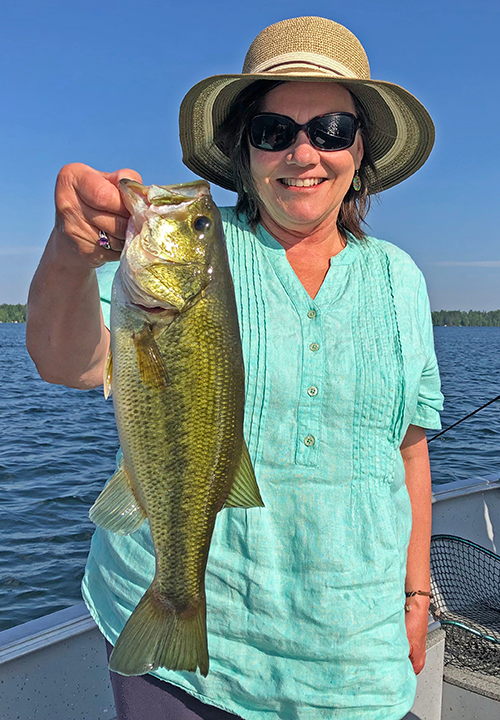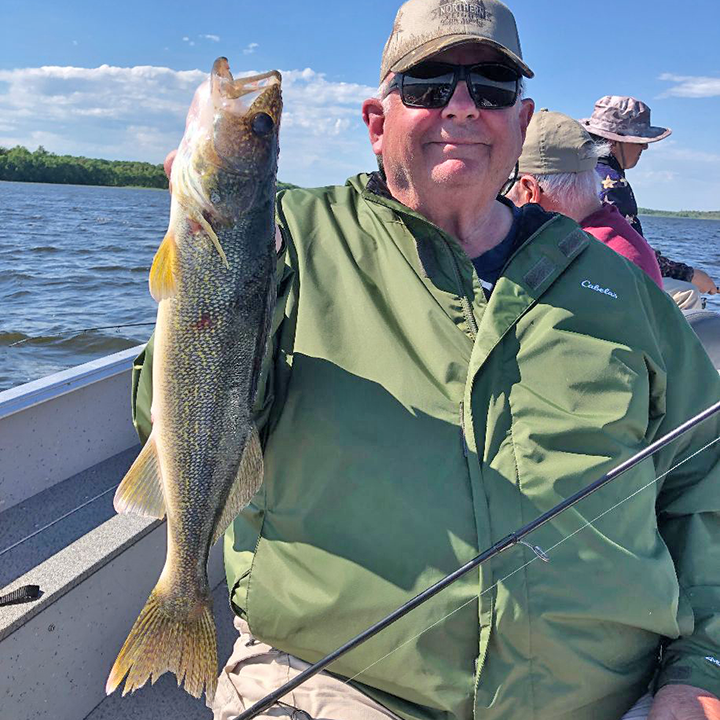The scene at our marina gave a sneak preview of what was in store for us as we headed out onto Cutfoot Sioux and eventually, Lake Winnie. Fall colors setting in along the tree line, a bright blue September sky and puffy “cotton ball clouds”. Now, if the fish would just happen to be biting, we’d be tempted to call this place paradise.
The scene at Bowen Lodge Marina Tuesday September 2021
Paradise it is!
Walleyes were on the prowl this Tuesday, even on the heels of a major line of thunderstorms blew through the region on Monday. We had to do a little searching to find the right spot, but once we were in ‘em, the classic shallow water, jig and minnow bite kept us busy for the whole afternoon.
Surface water temperatures did not fall as much as we expected, even after the cold air that settled in after Monday’s heavy rain. In Cutfoot, 63 to 64 degrees was the range we observed and on the big lake, 62 to 63 degrees was more typical. Water clarity was still fairly low, we could not see the bottom in 5 feet. We’re not sure if this is due to an “algae bloom” that’s hanging on, or residual cloudiness caused by the turbulent weather. Either way, the murky water conditions encouraged walleyes to continue prowling the shallows.
Walleye action on Winnie is fast and the scenery is beautiful; Paradise It Is! Photo courtesy Kyle Reynolds.
Key depths range from 4 to 6 feet of water, but in calm areas, fish could be located deeper. Reports of catching walleyes in 10 to 16 feet of water are not uncommon, so if the wind dies, or you’re fishing on the calm side of the lake, don’t be afraid to experiment.
Key structures include both vegetation and rocks. The hard bottom, gravel and rock patches in shallow water are best during windy periods. Deep rocks are a better choice when it’s calm and so is any good patch of cabbage, coontail or eelgrass; they will hold fish even under sunny skies and flat-water conditions.
Key presentations continue to be jig and minnow, spinners, and crankbaits. But it is worth noting that some of our friends were on the lake this Tuesday and reported that this was the first fishing trip of the season that required only 1 rod per person. A 1/8-ounce jig, tipped with large fatheads caught walleye, perch, rock bass and pike all day long. There was never a time when the crew felt any temptation to vary, or experiment with alternate presentations.
For the moment, most of the walleye action continues to be on Lake Winnie. But some of our guests are catching fish on Cutfoot as well. Knowing the reputation for fall walleye fishing that Cutfoot has, it’s obvious that the best is yet to come. But every day, there are a few more walleyes wandering in from Winnie, along with resident fish moving out to the edges of heavy vegetation as it begins to die off and thin out.
Some Winnie Walleyes from the 2018 year class are stretching their way toward 16 inches.
Walleyes from the 2019-year class, 12-1/2 to 13-1/2-inch fish, still dominate the action. But there are more and more fish from the also strong, 2018-year class showing up every day and the size is become highly desirable. In fact, anyone with an extended time frame could easily set a bottom end size for “keeper walleyes” at 15 inches. For folks who are on a day trip, or in a pinch for time, a 14-inch minimum would be more realistic and fairly easy to accomplish. But even they will find a smattering of the larger, 2018-year class fish in the mix. Over the past week, some examples were observed that came close to already reaching the 16-inch mark!
Every fall we see an uptick in the number of large fish caught during the harvest moon. Last week was no exception, large walleyes, large pike, and even larger perch were reported by both guests and some of the local guides. There will be another “big fish boom” down the line and some of the larger fish will continue to run even now. But we think that most folks should expect to see the sizes trending back toward smaller fish as the true, fall walleye migrations progress over the next week.
Panfish, as we reported last week have taken a back seat to the walleye fishing. But there are folks seeking out and catching both crappies and sunfish. As of last week, there were still a lot of panfish located in shallow water vegetation. As the cooling trend continues, there will almost certainly be an uptick in panfish action. We’ll focus more on that for the next report.
If you’re on the way to the lake for this weekend, you should arrive just in time for the peak of fall colors and if trends continue their present course, the peak of fall walleye fishing too! When you’re in the area, stop in and say hello.





















